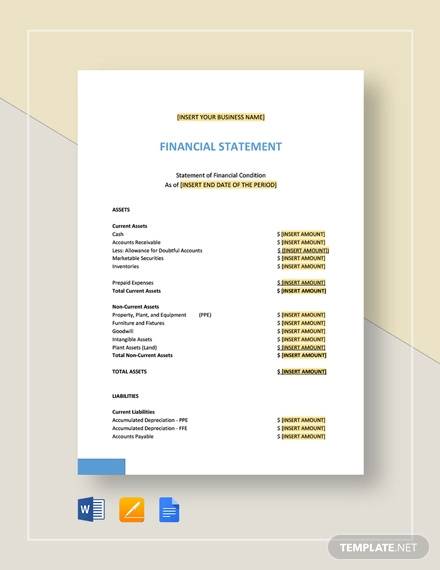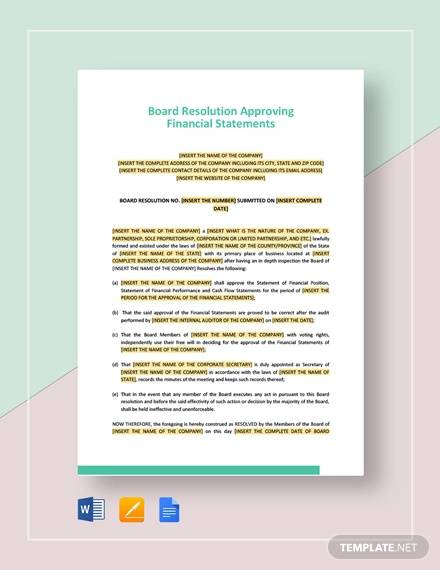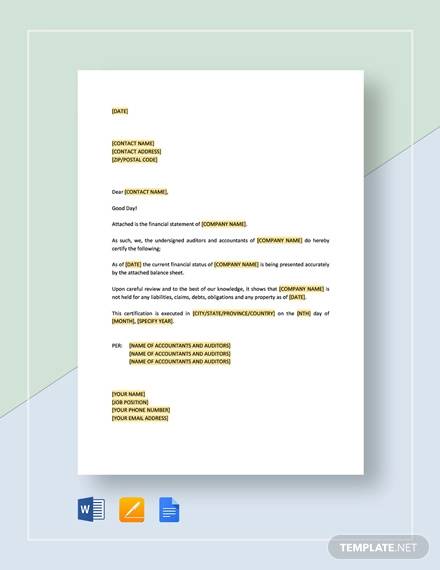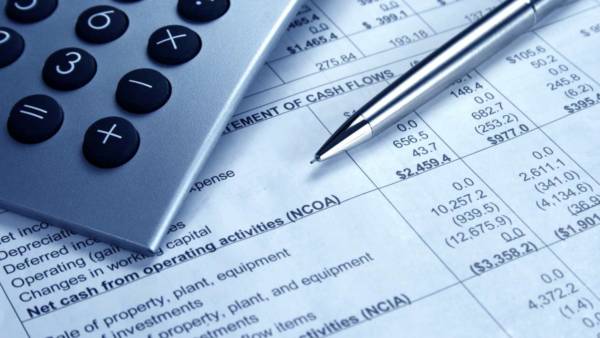When it comes to your business, you want to make sure that the operational flow on a daily basis is going smoothly. In line with ensuring that operations are going as smooth as possible, making sure that your finances are in check should also be a priority. The key documents that you would need to make sure that your finances are in good shape are financial statements.
If you are a newbie in the business world, you might wonder what are the essential financial statements that are needed for your business. Worry not as we are here to help you out! We will help you figure out what you need to prepare and what the purpose of each statement financially is. Are you ready to learn more about these basic types of financial statements? Just make sure that you keep reading this article!
Financial Statement

Board Resolution Approving Financial Statements Template

Certification Enclosing Financial Statements Template

What Are Financial Statements?
Keeping track of your business’s financial statements is one way of making sure that your business is on the right track and that your business will be sustainable in the coming months or even years to come. The financial statement of your business will also serve as your business’s financial report which will let you know how much money comes in, how much money goes out, and where your money actually goes.
It will also give you an idea what the assets and liabilities of your business are. Small and large businesses alike both need to make sure that their financial statements are updated on a regular basis. This will ensure that you have access to accurate and latest financial information samples that your company has.
Why Are Financial Statements Considered Important?
Your financial statements keep a record of the monetary activities that your business currently has and helps to make you understand where your business stands in the industry. But why are these documents considered to be important? We are here to help you figure that out.
- Financial statements will help you figure out what your proper approach should be with regards to your marketing strategies. You can check out marketing strategies checklist samples and templates to make it easier for you to come up with a good marketing strategy for your business.
- As your business grows, you want investors to invest in your business to help you make expansions. To make your business more attractive to investors, you want to make sure that your business is going steady in terms of finances. By checking your financial statement analysis, you would know which areas of the business you would need to focus on and ensure that your business is worth the investment.
- By keeping your financial statements in check, you will know where your money goes and what you can do to reduce your spending should there be a need to do so.
You can find out more basic information about financial statements by checking out Things You Need to Know about Financial Statements.
The Three Basic Financial Statements Needed for Your Business
Making sure that your finances are in great shape on a daily basis is of high importance. This is true especially if you want to take your business to the next level and make sure that investors get attracted to what your business has. With financial statements, you will also be able to know if you are doing well in line with the current trends and if the prices you have for your products are competitive enough and if they can help you sustain your business in the long run. You can also like income statement samples.
Getting started on a new business can be a challenge and you might still get confused about the ins and outs of your business’s financial activity. But we are here to help you have a better understanding about all the necessary financial statements that are needed in your business. Here is a glimpse of what these financial statements are.
1. Balance Sheet
From the word balance, a simple balance sheet is a financial statement that would help you see if the liabilities that you have plus the owner’s equity or the capital would be equal to the assets of your business. In equation form, it would look like the following: Liabilities + Owner’s Equity = Assets.
These items in your sheet would typically be listed in columns. Both equations should be equal at the end of the specified period in your sheet. To make things a little easier to understand, let us define assets, liabilities, as well as owner’s equity. You may also like statement of interest samples.
- Assets. Assets refer to the property owned by a business entity. These are items that are considered to be convertible to cash and can be used to pay off any debts that the business may have. There are two types of assets: current assets and fixed assets. You may also like sworn statement samples.
- Current Assets. Current assets, also known as current accounts, are cash as well as those items that can easily be converted into cash within a period of one year. Some common examples of assets that fall in this category are the following:
- Cash (both local and foreign cash)
- Prepaid expenses or expenses that have been paid in advanced
- Accounts receivables or payments that will be received within the year
- Investments
- Inventory
- Fixed Assets. Fixed asset inventory, on the other hand, are those assets that have been purchased for long-term usage and are difficult or challenging to turn into cash. These assets are tangible and are more often than not used in producing goods and products to be sold by the business to its consumers. Some assets included in this category would include
- Machinery,
- Equipment,
- Land,
- Buildings, and
- Furniture.
- Current Assets. Current assets, also known as current accounts, are cash as well as those items that can easily be converted into cash within a period of one year. Some common examples of assets that fall in this category are the following:
- Liabilities. Within the course of a company’s operations, having debt and other financial obligations is quite inevitable. These financial obligations are the items that fall into liabilities. This can also be broken down into two types of liabilities: current liabilities and long-term liabilities. You can also like privacy statement samples.
- Current Liabilities. Current liabilities, also known as short-term liabilities, are the financial debts and obligations of a business that is payable within one year. These would include
- Accounts payable to suppliers that are usually stated in sales invoice template of the supplier;
- Taxes payable such as sales taxes, payroll taxes, as well as income taxes;
- Short-term advances in the bank;
- Deposits;
- Short-term loans (payable within 12 months); and
- Matured long-term debt or the portion or amount of a long-term debt that is due in the next 12 months.
- Long-Term Liabilities. Long-term liabilities are the financial obligations of a business that are not payable within 12 months. They are also known as non-current liabilities. These would include. You can also like victim statement samples.
- Deferred payments for compensation, revenues, as well as income taxes;
- Capital leases;
- Bonds payable or payables that were issued by the hospital, corporations, and governmental bodies;
- Retirement investments;
- Pension liabilities; and
- Other derivative liabilities.
- Current Liabilities. Current liabilities, also known as short-term liabilities, are the financial debts and obligations of a business that is payable within one year. These would include
- Owner’s Equity. Owner’s equity represents the amount that has been invested by the owner for the business. In equation form, it is the total assets minus the total liabilities (Total Assets ? Total Liabilities = Owner’s Equity). Some items that fall into this category are:
- Stocks, both preferred and common;
- Excess cash received from the shareholder’s;
- Retained earnings from the previous years; and
- Accumulated income.
When investors think of investing in your business, they would inspect your balance sheet first and foremost. Think of your accounting balance sheet as your window to getting the attention of possible investors.
Why? This is due to the fact that your balance sheet gives a good summary of the overall performance of the business. If your business is doing good and has good control of the finances for a given period of time, it is also a good indicator of the company’s stability and liquidity, which is what investors are looking for.
2. Cash Flow Statement
The cash flow statement is the financial statement that keeps a record of how much money comes in and out of the company.
- Cash Inflow. This refers to the money that comes in the business. This would typically include receivables and cash sales.
- Cash Outflow. This refers to the amount of money that goes out of the company due to purchases, paid expenses, inventory, and other payments that have been made during the specified period.
To know if your company has enough cash to stay afloat, you would definitely want to check out your business’s cash flow statement. However, it does not necessarily mean that just because your business is profitable that you would not encounter any problems along the way. Remember, cash that comes in does not come in the same rate that it goes out. You may also like personal statement samples.
Sometimes, the latter is way faster that the former. You want to make sure that there is a good balance between the two to ensure that your business does not fail as this is where most businesses fall short. Just make sure that you keep your cash flow template as updated as possible for a more accurate preview of your cash flow. You can check out Cash Flow Analysis Samples to know more about analyzing your cash flow better.
3. Income Statement
What is an income statement? An income statement or profit and loss statement is a type of financial statement that would help you determine if you have profits or if you are losing from your business operations. This sheet would also help you project the sales and expenses that you would have within the year.
You will typically see three parts of an income statement:
- Total Revenues. Total revenue refers to the cash earned by a business before they start paying their expenses. It is calculated as Price of the Good Sold multiplied by Quantity Sold or P × Q.
- Total Expenses. Total expenses refers to the total sum of your financial obligations that were spent during the specified period. This would include purchases, utilities, rent, credit card payments, etc.
- Net Income. This refers to the Gross Profit minus Total Operating Expenses.
Your income statement format is important in making sure that your business would be profitable in the future. By reviewing your income statement, you will have a good idea about the risks that are involved should you prefer to extend spending, credit, and capital for your business.
Now, you have a better understanding about what are the basic financial statements needed by your company. You may think that one is more important than the other but you will see that each financial statement plays a vital role for the other as they are all interconnected.
As time goes by, you will find that you will start getting used to checking out these numbers and you will also find yourself being able to come up with strategies that will help you grow your business in a healthy yet steady manner. You will be able to start making smarter decisions for your business. For more information and samples, you will find that reading about Essential Business Financial Statement Samples and Templates on this very website will be of great help to you, your staff, and your business.
Related Posts
FREE 10+ Scholarship Statement of Purpose Samples in PDF | DOC
FREE 10+ Engineering Problem Statement Samples [ Software, Mechanical, Civil ]
FREE 30+ Information Statement Samples in PDF | MS Word
FREE 50+ Policy Statement Samples in MS Word | Google Docs | PDF
FREE 50+ Summary Statement Samples in PDF | MS Word
FREE 10+ Nursing School Personal Statement in PDF
FREE 9+ Mortgage Statement Samples and Templates in PDF
FREE 10+ Independent Subcontractor Statement Samples in MS Word | Google Docs | Apple Pages | PDF
FREE 10+ Trust Distribution Statement Samples in PDF
FREE 14+ Compliance Statement Samples & Templates in PDF | MS Word
FREE 10+ Extension Impact Statement Samples in PDF | DOC
FREE 10+ Bank Reconciliation Statement Samples and Templates in PDF | MS Word
FREE 10+ Diversity Mission Statement Samples in MS Word | PDF
FREE 10+ Architecture Statement of Purpose Samples [ Sustainable, Graduate, Master ]
FREE 13+ Project Scope Statement Samples in PDF | MS Word
